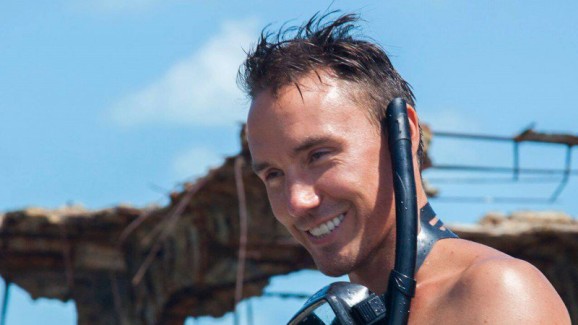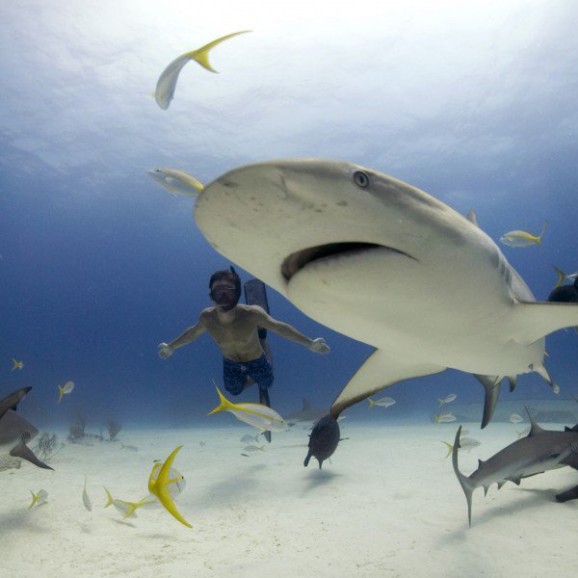What Happened to Rob Stewart?
The director of the acclaimed documentary ‘Sharkwater’ disappeared mysteriously after a deep dive off the coast of Key Largo on Tuesday. For 72 hours, crews scoured the ocean. On Friday, shortly after the search for Stewart was suspended, divers found his body on the bottom of the ocean floor.
February 3, 2017

On the morning of Tuesday, January 31, filmmaker and shark conservationist Rob Stewart boarded a dive boat docked at Caloosa Cove Marina on the tiny isle of Islamorada, just south of Key Largo. The 37-year-old had one goal, to find the elusive sawfish, an impossibly cute, cartoonish creature of the deep with the body of a shark and a beak that best resembles a chainsaw. Sawfish are shy and easily scared off by the stream of bubbles and Darth Vader-eque growl that comes from a scuba rig. On Tuesday, Stewart would be diving with a rebreather, a closed circuit system that recycles the carbon dioxide a diver exhales into breathable air. Which means stealthy, silent swimming without bubbles.
The rebreather Stewart was using looks like a suitcase with shoulder straps and an inflatable wing. It enabled him to go deeper and explore his maximum depth longer with less decompression time than other technical diving rigs. An experienced diver with hundreds if not thousands of dives in his logbook, Stewart was new to rebreathers. More than a month before setting sail to find the sawfish, on December 19, Stewart posted to Facebook: “looking for a rebreather dive ninja mid January in Florida for some 300ft dives…”
He’d already connected with an instructor named Peter Sotis who owns Add Helium, a dive shop in Ft. Lauderdale. According to a since-deleted Facebook post, Sotis put Stewart through a rebreather tri-mix course in late January. On January 31, Stewart and his friend and collaborator Brock Cahill chartered a dive boat through Horizon Divers, a dive shop in Key Largo to visit The Queen of Nassau wreck, six nautical miles off the Florida Keys, in search of the sawfish. The boat’s owner, Dan Dawson joined them. So did Sotis, who according to email communications was tagging along as a safety diver.
Conditions were ideal: a refreshing 10-to-12-knot breeze was blowing and the azure ocean rippled with a mellow swell of 1-to-3 feet. Donning dry suits, Sotis and Stewart dropped into blue water, descending to 230 feet. Stewart brought his camera with him as they finned down toward the 111-year-old Canadian steamship, its skeleton encrusted with coral. The purpose was to shoot footage for Stewart’s next project, a documentary called Sharkwater Extinction, the sequel to his 2007 award-winning film, Sharkwater, which received broad acclaim for revealing shark finning to a wide audience. It not only made him a celebrity in the marine and conservation community but inspired global efforts to ban shark-finning.
Stewart and Sotis dove the wreck three times that day. They were the deepest dives of Stewart’s life. The two men surfaced for the final time just after 5 p.m. within sight of the dive boat’s crew members. Stewart gave the OK sign. Sotis, however, appeared shaky as he climbed aboard the boat. Moments later, he blacked out. The crew retrieved bottled oxygen to revive him. In the commotion, they turned their backs to the water, and when they again looked for Stewart in the water, he was gone. The crew radioed for help immediately. Within five minutes, a Navy helicopter was dispatched and Coast Guard cutter Sexton was diverted to the scene, along with a small boat crew and an HH-65 helicopter from Miami.
Stewart, born and raised in Toronto, Ontario, always loved the ocean. At his behest, he, his parents, and his older sister all got Professional Association of Diving Instructors-certified for his thirteenth birthday. “For the next 15 years, all of our family vacations were dive vacations,” Alexandra Stewart, Rob’s sister, told Outside. “It was such an overwhelming passion for him, and he was so good at it he made the beauty of diving accessible to us. It was clear that [diving] was going to be a huge driver in his personal and professional life.”
Stewart went on to study biology at Ontario’s Western University and traveled whenever he could. He blossomed into a formidable photographer and cameraman, eventually landing in Los Angeles. Young, handsome, passionate, and skilled, he found a mentor in the legendary anti-poaching activist Captain Paul Watson, founder of Sea Shepherd, the global anti-poaching armada known for its defense of whales and campaigns against illegal fishing worldwide.
Stewart boarded Sea Shepherd’s Ocean Warrior in 2002 to film Watson in his element, battling Costa Rican shark poachers. Watson and his team had showered the poachers with water cannons, slammed into their vessel, and attempted to take control of their boat. Both men, with the rest of the Ocean Warrior crew, were subsequently arrested by Costa Rican authorities for attempted murder as a result. They slipped custody and used the footage to expose a vast international and illegal shark-finning cartel.

That footage is some of the most compelling action in Sharkwater, Stewart’s 2006 acclaimed documentary, which explains how the ocean’s apex predator has driven the evolution of marine species for over 400 million years and plays a pivotal role in climate stabilization (by feeding on species that eat plankton, which transform carbon dioxide into oxygen). It was a visually striking portrayal: early on in the film, Stewart kneels on the sea floor, petting sharks swirling around and nuzzling him.
“You’re told your whole life since you were a kid, sharks are dangerous,” Stewart narrates. “You’re warned not to go adventuring too far out into the ocean, but then finally… you see the thing you were taught your whole life to fear, and it’s perfect, and it doesn’t want to hurt you, and it’s the most beautiful thing you’ve ever seen. And your whole world changes.”
“He wanted to show that the shark was a beautiful creature, essential to our ecosystem and not to be feared,” Watson said in a phone interview on Thursday. “It presented sharks in a new light and changed the perspective of millions of people.”
Sharkwater was screened in dozens of film festivals around the world, and Stewart made the rounds, wracking up awards and television appearances. “It made a huge impact,” said David McGuire, founder of the San Francisco nonprofit Shark Stewards. “It is still the most influential anti-shark-finning film.”
Due in part to the film’s release, global trade in shark finning in the past decade has been reduced by a third, according to McGuire. In Hong Kong, McGuire estimates the shark fin trade has been cut in half. China no longer serves shark fin soup at state dinners, and Air China, DHL, and UPS have all banned shark fin transport. So has COSCO, one of the world’s largest ocean shipping conglomerates. “We’re winning the battles,” McGuire said, “but we haven’t won the war.”
Last November, around the time he discovered an illegal blue shark trade in Cape Verde, Stewart decided it was time for a follow-up documentary. In an Instagram post on November 20, he said up to 1,500 blue sharks were being caught each day and shipped to plants in Spain to be ground into pet food. Filming was set to wrap in the coming weeks, with a premiere planned for the Toronto International Film Festival in September.
Authorities searched for Stewart all Tuesday night. By Wednesday morning a fixed-wing aircraft was added to the fleet, augmented by 20 volunteer boat crews, including the John Paul Dejoria, Sea Shepherd’s newest member of its fleet, and 12 civilian aircraft—among them Richard Branson’s helicopter and Jimmy Buffet’s private plane. Thirteen scuba divers searched for him too, though they were unable to reach the bottom due to visibility issues. The search continued into Thursday when the U.S. Border Patrol deployed a remotely operated vehicle (ROV) capable of lifting up to 200 pounds on the ocean floor. In 48 hours, crews scoured more than 1,300 square miles to no avail.
Coast Guard Captain Jeffrey Janszen, commander of the search and rescue operation, said Thursday that he was confident in their search pattern, which was based on Stewart’s last known position and dictated by both computer models of current and weather patterns and a self-locating buoy that was deployed in the minutes after he went missing. “Based on real time data, that [buoy] is drifting smack in the middle of our search pattern,” Janszen said Thursday. “We’re saturating the area.”
Stewart’s parents arrived in the Keys on Wednesday morning, they appeared desperate and confused in a Canadian television interview in which they appealed for volunteers to help with the search. Tech divers I spoke to during the search reiterated one question about the circumstances of Stewart’s disappearance: Why had Stewart and Sotis attempted three deco dives (meaning deep dives that carry a greater risk of decompression sickness) in one day? Most experienced rebreather divers would attempt two such dives at most.
“When you use a rebreather, you have to start from scratch,” said Simon Liddiard, owner of Blue Marlin Dive in Indonesia and a rebreather instructor for 20 years, when asked about Stewart’s disappearance. “It doesn’t matter how many years you’ve been a diver. You have zero experience.” Liddiard explained that it’s easy for beginners to accidentally flood the breathing loop, which can drag a diver down. Mixing the gases is also potentially dangerous: if a diver were to accidentally breathe hypoxic gas at the surface, he could black out and sink.
The search continued until 4:30 p.m. Eastern Time on Friday, when Captain Janszen issued an order to suspend it. Crews had been searching nonstop for 72 hours, and according to Janszen, Stewart had “reached the end of feasible survivability.”
Minutes later, a dive team from Key Largo Fire and Rescue found Stewart’s body. It was 300 feet from his last known position, on the bottom of the ocean floor.
On Thursday, Stewart’s sister, Alexandra, reminisced about diving in Boanaire, the Cayman Islands, and even Lake Muskoka, north of Toronto. “The whole family love water and nature,” she said, “but he was so passionate. Once he took us swimming and showed us the most amazing little seahorse hiding in the crack of a monolithic [cement] dock.” Along with helping to curb shark finning, perhaps that’s his legacy. In death as in life, Rob Stewart was an interpreter of the ocean’s beautiful secrets.
